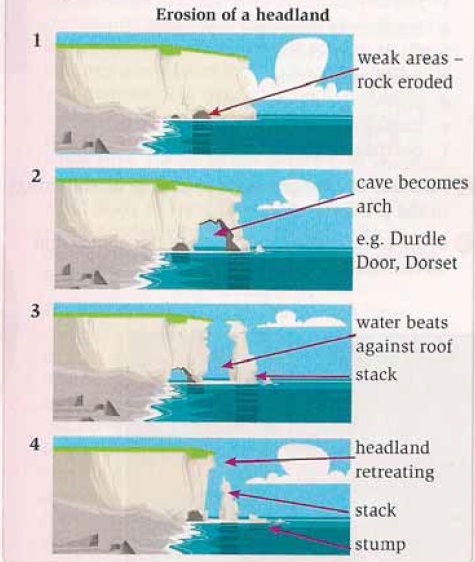The diagram below show the stages in the erosion of a headland.
A breakdown of the natural process of headland formation due to coastal erosion is presented in the diagram. Overall, it is immediately apparent that there are four primary stages which begin with rock destruction and cave formation. The following processes consist of the result of leaving top layer, stack and stump, subsequently.
The first sequence in the erosion of a headland is deformation stage. In this stage, sea wave which has different pressure attacks the less vulnerable area of the rock layer, and it results in forming a small cave. Next, the cave becomes larger and larger in size, before creating a various arch shape, such as Durdle, Door, and Dorest.
The further process is called stack formation in which sea water hits the arch's roof continuously. As the consequence, the massive roof collapses into the sea level, and it leaves a separated land in the ocean, called a stack. Afterwards, the water still erode the stack and the headland simultaneously, meaning that its length become narrower. Eventually, the process remains a small pieces of stump opposite the headland.
A breakdown of the natural process of headland formation due to coastal erosion is presented in the diagram. Overall, it is immediately apparent that there are four primary stages which begin with rock destruction and cave formation. The following processes consist of the result of leaving top layer, stack and stump, subsequently.
The first sequence in the erosion of a headland is deformation stage. In this stage, sea wave which has different pressure attacks the less vulnerable area of the rock layer, and it results in forming a small cave. Next, the cave becomes larger and larger in size, before creating a various arch shape, such as Durdle, Door, and Dorest.
The further process is called stack formation in which sea water hits the arch's roof continuously. As the consequence, the massive roof collapses into the sea level, and it leaves a separated land in the ocean, called a stack. Afterwards, the water still erode the stack and the headland simultaneously, meaning that its length become narrower. Eventually, the process remains a small pieces of stump opposite the headland.

286887_1_o.jpg
